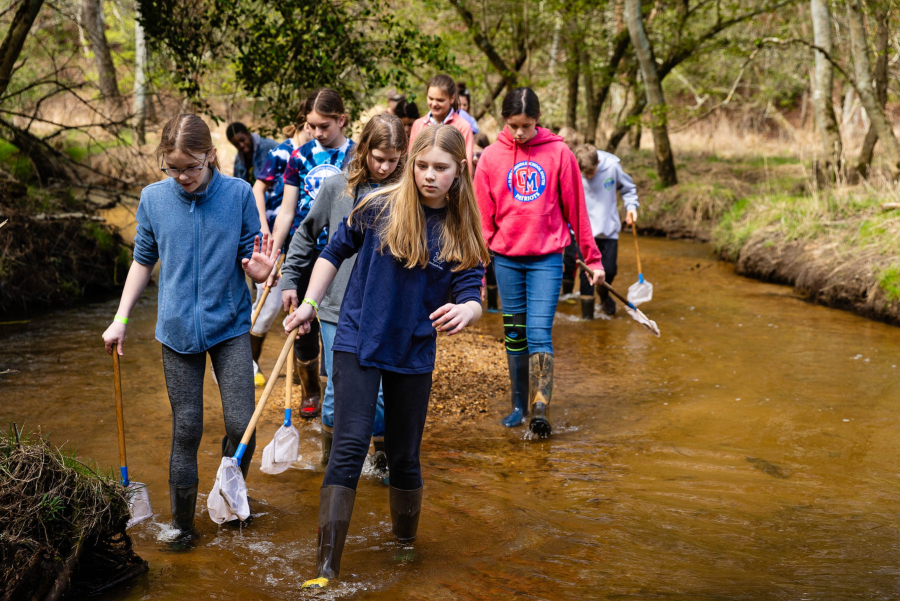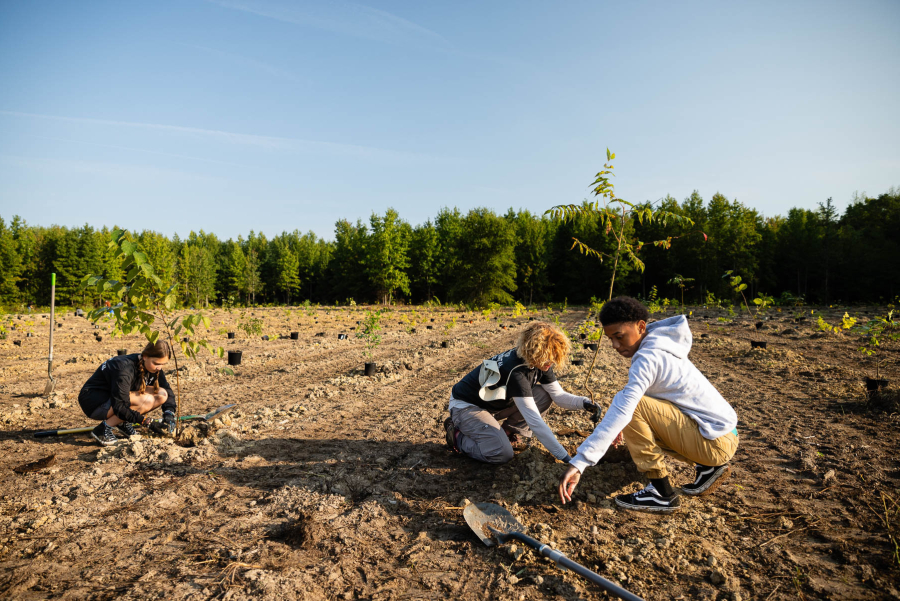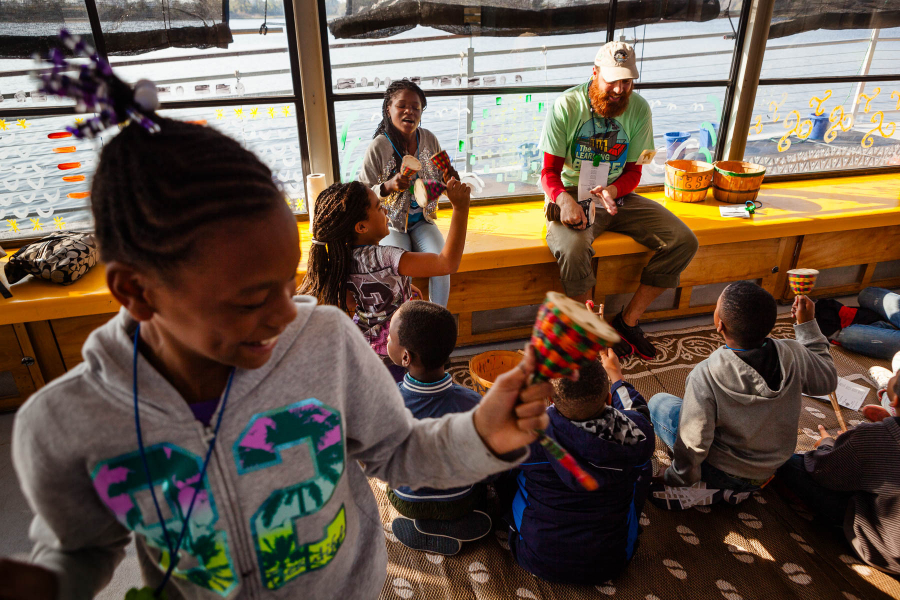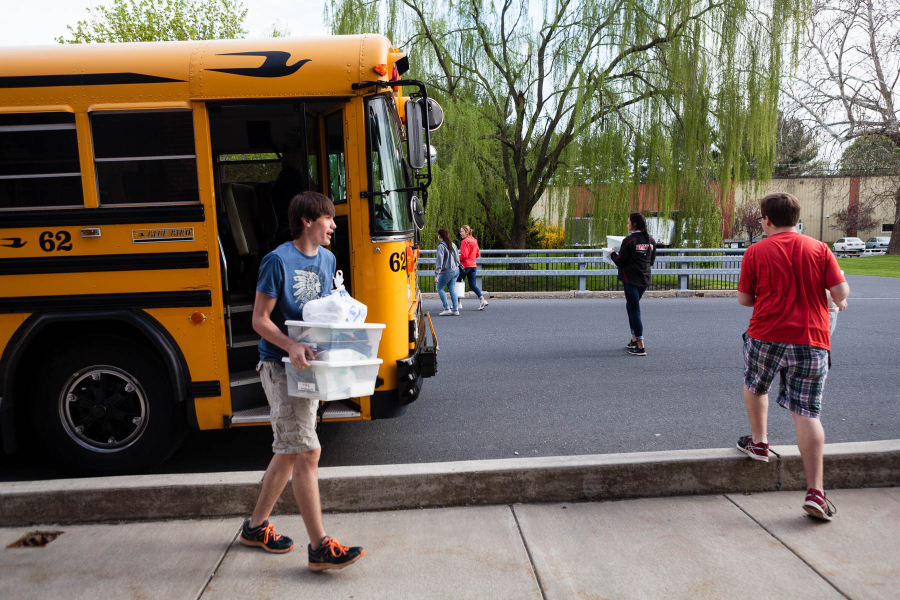40 years of educating Chesapeake Bay stewards
NOAA plays a key role in the Bay Program’s environmental education efforts

For four decades, the Chesapeake Bay Program has focused on protecting and restoring the Chesapeake Bay. An important part of this work is ensuring that students all across the watershed learn why the Bay is such a special place. To advance the effort to protect and restore the health of the Chesapeake, young people need to learn how their decisions and actions can help create a brighter future for the Bay. Ensuring that youth build the skills needed to thoughtfully care for the waters and watershed around them is therefore key to the long-term success of the Chesapeake restoration effort.
The Chesapeake Bay Program has long recognized the importance of educating the next generation of stewards. The first Chesapeake Bay Agreement in 1987 included a commitment to “provide curricula and field experiences for students.” An important first step—but policy and practice have evolved greatly since then. Education specialists and policy experts at the National Oceanic and Atmospheric Administration (NOAA) Chesapeake Bay Office have been deeply involved in these efforts over the past 20 years and continue to play key roles in the Chesapeake Bay Program’s work to grow environmental literacy.
To ensure partners were working toward the same goals, the Chesapeake Bay Program’s Education Workgroup defined the Meaningful Watershed Educational Experience—the “MWEE”—in 2001. MWEEs are student experiences that include learning both outdoors and in the classroom. They actively engage students in building knowledge and meaning through hands-on, student-centered learning experiences. MWEEs are the gold standard for environmental education in the Chesapeake Bay. The Chesapeake Bay Program’s Executive Council endorsed MWEEs as an essential element toward meeting the Chesapeake Bay Program’s goals.
“The Chesapeake Bay Program has brought leaders of the education and natural resources community together to make real, positive change for students and the environment like no other part of the country,” said Tom Ackerman, vice president of education, Chesapeake Bay Foundation. “By building and sharing frameworks like the Meaningful Watershed Educational Experience, we have been able to model and implement exemplary education that helps students learn about, care about, and act to protect the local environment on the scale of entire school systems, communities, and states.”

Supporting MWEEs through NOAA B-WET
Realizing the need to support the development of MWEEs throughout the region, in 2002, NOAA started the Bay Watershed Education and Training (B-WET) program. While its first node was established in the Chesapeake Bay, B-WET now includes seven areas across the country. It has awarded $117 million to 929 B-WET projects nationwide in the past two decades. In the Chesapeake Bay watershed alone, B-WET has supported more than 730,000 student experiences and nearly 30,000 professional development opportunities for educators.
While initially, Chesapeake B-WET provided funding for smaller-scale, one-time projects—like getting students from a few classrooms in a school to engage in a MWEE or a stand alone teacher training—efforts have evolved over the years.
B-WET now funds projects that ensure MWEEs dramatically increase the program’s reach on a systemic level. This effort ensures that all students within the school district benefit from this robust experience. B-WET education experts also recognized that in order for school districts to sustain these MWEEs over time, they needed funding to build capacity for things like partnerships with other organizations, ongoing teacher training and creating environmental literacy plans. The program now provides grants to ensure that districts can support this foundational work.
“B-WET set the vision for Boxerwood since we were just getting started in developing programs for our new organization. Boxerwood educators learned watershed science and pedagogy through the MWEE model and associated professional development: we teach the way we teach because of NOAA,” said Elise Sheffield of the Boxerwood Education Association, which has received NOAA B-WET grants.

Enhancing experiences through resources
To reach our environmental education goals, NOAA and other Chesapeake Bay Program partners have developed numerous online resources that help educators develop MWEEs that are relevant to their students. These resources include:
Published in 2017, the Educator’s Guide to the Meaningful Watershed Educational Experience helps educators build effective MWEEs. This resource was so well received that in 2022, NOAA published an updated version intended for national audiences.
The Facilitator’s Guide to MWEE Training provides resources and guidance on how to train others on the framework.
The online MWEE 101 course teaches how students and educators can work together to implement the student-centered framework. Since 2019, more than 1,800 people have completed the course.
Educators also use Bay Backpack to learn MWEE basics, access teaching resources, learn of environmental action projects and discover outdoor learning locations.
As the B-WET program has evolved over the years to move towards school district-wide MWEE programs, so have the resources. District leaders from across the region are using the newly created District Environmental Literacy Planning Toolkit to guide them through the process of planning environmental literacy programming throughout a student’s K-12 career.
Each state has built unique networks
While the six watershed states and Washington, D.C., have collectively committed to supporting environmental literacy, each jurisdiction has also put its own spin on how to grow these education efforts within its borders. Coordination through the Chesapeake Bay Program has supported an aligning of resources—federal funding, state policies and district-level connections with non-formal education partners. In each jurisdiction, these efforts have resulted in unique accomplishments:
Delaware has focused on developing a state-wide network of environmental literacy stakeholders and identifying opportunities to integrate environmental literacy into career and technical education pathways.
West Virginia has developed a robust Outdoor Learning Network Initiative that helps schools, nonprofits, colleges and universities, and other organizations partner on local projects.
Pennsylvania developed new Science, Technology, Engineering and Environmental Literacy (“STEELS”) standards for how these topics are taught in public schools across the state. STEELS include elements of the MWEE framework.
Maryland established a requirement that all students must graduate from high school environmentally literate. This is possible because the state also requires each local school education agency to provide course offerings aligned with the Maryland Environmental Literacy Curriculum.
Virginia connected MWEEs to the Profile of a Virginia Graduate and established the Virginia Board of Education’s Seal for Excellence in Science and the Environment.
Washington, D.C., initiated the Green and Healthy Schools Act, which led to development of an environmental literacy plan for the District.
New York engaged in a state capacity-building effort led by Otsego County Conservation Association. This work has increased MWEE awareness and implementation in schools within the upper reaches of the Chesapeake Bay watershed.
Environmental literacy leaders from Delaware, Maryland, Pennsylvania and Virginia have developed a capacity-building effort called the Regional Outdoor Learning Network. This effort aims to strengthen state-level networks. It is organized in partnership with Local Concepts, which provides training and technical support to new and existing state networks. The initiative has resulted in the creation of the Virginia Environmental Literacy Network, the Maryland Environmental Literacy Network and Delaware Environmental Literacy and Communities in Nature Network as well as the strengthening of the Pennsylvania Environmental Literacy Network. These state networks are all working to strengthen relationships and collaboration to cultivate the conditions for equitable environmental literacy efforts to grow and thrive in the state ecosystem.

Partnerships make it possible
While NOAA experts have led the Bay Program’s Education Workgroup for many years, and NOAA Chesapeake B-WET is a primary source of funding for environmental literacy efforts, the expansion of these efforts could not have happened without highly collaborative partnerships. State departments of education have leaned in to develop the policies that are the best fit for their jurisdiction. Nonprofit organizations have partnered with school districts to provide experts to help students learn about the Chesapeake Bay. Notably, the Chesapeake Bay Foundation has been involved in environmental education for 50 years, helping deliver student experiences as well as professional development for educators.
Other partners around the watershed have provided important perspectives and capabilities. The Environmental Protection Agency has provided funding, and the U.S. Department of Education’s Green Ribbon program encouraged an emphasis on environmental education. More local partners have been standouts, too, including the Chesapeake Bay Trust, Maryland Department of Natural Resources and Pennsylvania Department of Environmental Protection, which have all aligned their environmental education grants programs to support the Bay Program’s goal for all students to engage in MWEEs.
All this collaboration has supported great progress toward the goal to “enable every student in the region to graduate with the knowledge and skills to act responsibly to protect and restore their local watershed” as set forth in the Chesapeake Bay Watershed Agreement of 2014. Chesapeake Progress currently tracks accomplishments toward outcomes for students, sustainable schools and environmental literacy planning.
Environmental literacy is good for students and for the Chesapeake Bay. The next generation of Bay stewards is graduating from high school with the necessary knowledge to make good decisions for the Chesapeake and their local waters. And in 2017, the North American Association for Environmental Education and Stanford faculty member Nicole Ardoin published a literature review that showed that students who participated in environmental education programs also manifest skills that will serve them well in other areas as they enter the workforce.
Next steps
While jurisdictions and school districts around the Chesapeake Bay watershed have made significant commitments to ensuring students become environmentally literate, climate change adds a new layer to these priorities. Leaders in the Chesapeake environmental education community will convene at the biennial Environmental Literacy Forum in November 2023 to focus on how to tackle some of these challenges, including identifying high-impact actions for sustainable schools and how to develop a workforce ready to take on climate challenges. However environmental education efforts evolve in the coming years, the MWEE will remain a central concept in how Chesapeake students learn about their watershed.

Comments
There are no comments.
Thank you!
Your comment has been received. Before it can be published, the comment will be reviewed by our team to ensure it adheres with our rules of engagement.
Back to recent stories